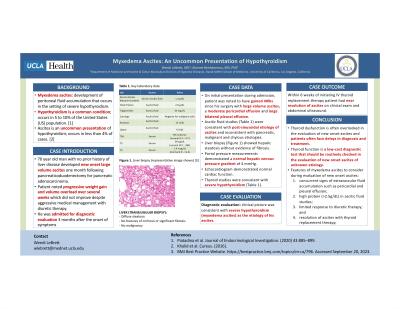Monday Poster Session
Category: Liver
P2466 - Myxedema Ascites: An Uncommon Presentation of Hypothyroidism
Monday, October 23, 2023
10:30 AM - 4:15 PM PT
Location: Exhibit Hall

- WL
Wendi LeBrett, MD
UCLA David Geffen School of Medicine
Los Angeles, California
Presenting Author(s)
Wendi LeBrett, MD, Jihanne Benhammou, MD, PhD
UCLA David Geffen School of Medicine, Los Angeles, CA
Introduction: Myxedema ascites describes the development of peritoneal fluid accumulation that occurs in the setting of severe hypothyroidism. While hypothyroidism is a common condition present in 5 to 10% of the United States population, ascites occurs in less than 4% of cases. We present a case of new-onset ascites secondary to hypothyroidism.
Case Description/Methods: A 70 year-old man with no prior history of liver disease developed new onset large volume ascites one month following pancreaticoduodenectomy for pancreatic adenocarcinoma. He noted progressive weight gain and volume overload over several weeks which did not improve despite aggressive medical management with diuretic therapy. He was admitted 3 months after the onset of symptoms and was found to have large volume ascites, a moderate pericardial effusion, and large bilateral pleural effusions. Ascitic fluid studies were notable for serum ascites albumin gradient (SAAG) of 1.3 g/dL, total protein 2.9 g/dL, negative cytology and low triglycerides; suggestive of post-sinusoidal etiology of his ascites. He underwent liver biopsy which showed hepatic steatosis without evidence of fibrosis. His portal pressure measurements demonstrated a normal hepatic venous pressure gradient of 4 mmHg. His echocardiogram demonstrated normal cardiac function. Thyroid studies were consistent with severe hypothyroidism: TSH 69 mcIU/mL (normal 0.3 – 4.7), T4 1.4 mcg/dL (normal 4.9 - 11.4) and T3 69 pg/dL (normal 222 – 383). Within 6 weeks of initiating IV thyroid replacement therapy, he had near resolution of ascites on clinical exam and abdominal ultrasound without further need for paracenteses.
Discussion: Thyroid dysfunction is often overlooked in the evaluation of new onset ascites and patients with myxedema ascites often face delays in diagnosis and treatment. Our case demonstrates several key features of myxedema ascites which should be considered during evaluation of new onset ascites: 1) concurrent signs of extravascular fluid accumulation such as pericardial and pleural effusion; 2) high protein ( >2.5g/dL) in ascitic fluid studies; 3) limited response to diuretic therapy; and 4) resolution of ascites with thyroid replacement therapy. Thyroid function is a low-cost diagnostic test that should be routinely checked in the evaluation of new onset ascites of unknown etiology.
Disclosures:
Wendi LeBrett, MD, Jihanne Benhammou, MD, PhD. P2466 - Myxedema Ascites: An Uncommon Presentation of Hypothyroidism, ACG 2023 Annual Scientific Meeting Abstracts. Vancouver, BC, Canada: American College of Gastroenterology.
UCLA David Geffen School of Medicine, Los Angeles, CA
Introduction: Myxedema ascites describes the development of peritoneal fluid accumulation that occurs in the setting of severe hypothyroidism. While hypothyroidism is a common condition present in 5 to 10% of the United States population, ascites occurs in less than 4% of cases. We present a case of new-onset ascites secondary to hypothyroidism.
Case Description/Methods: A 70 year-old man with no prior history of liver disease developed new onset large volume ascites one month following pancreaticoduodenectomy for pancreatic adenocarcinoma. He noted progressive weight gain and volume overload over several weeks which did not improve despite aggressive medical management with diuretic therapy. He was admitted 3 months after the onset of symptoms and was found to have large volume ascites, a moderate pericardial effusion, and large bilateral pleural effusions. Ascitic fluid studies were notable for serum ascites albumin gradient (SAAG) of 1.3 g/dL, total protein 2.9 g/dL, negative cytology and low triglycerides; suggestive of post-sinusoidal etiology of his ascites. He underwent liver biopsy which showed hepatic steatosis without evidence of fibrosis. His portal pressure measurements demonstrated a normal hepatic venous pressure gradient of 4 mmHg. His echocardiogram demonstrated normal cardiac function. Thyroid studies were consistent with severe hypothyroidism: TSH 69 mcIU/mL (normal 0.3 – 4.7), T4 1.4 mcg/dL (normal 4.9 - 11.4) and T3 69 pg/dL (normal 222 – 383). Within 6 weeks of initiating IV thyroid replacement therapy, he had near resolution of ascites on clinical exam and abdominal ultrasound without further need for paracenteses.
Discussion: Thyroid dysfunction is often overlooked in the evaluation of new onset ascites and patients with myxedema ascites often face delays in diagnosis and treatment. Our case demonstrates several key features of myxedema ascites which should be considered during evaluation of new onset ascites: 1) concurrent signs of extravascular fluid accumulation such as pericardial and pleural effusion; 2) high protein ( >2.5g/dL) in ascitic fluid studies; 3) limited response to diuretic therapy; and 4) resolution of ascites with thyroid replacement therapy. Thyroid function is a low-cost diagnostic test that should be routinely checked in the evaluation of new onset ascites of unknown etiology.
Disclosures:
Wendi LeBrett: Trellus Health – Consultant.
Jihanne Benhammou indicated no relevant financial relationships.
Wendi LeBrett, MD, Jihanne Benhammou, MD, PhD. P2466 - Myxedema Ascites: An Uncommon Presentation of Hypothyroidism, ACG 2023 Annual Scientific Meeting Abstracts. Vancouver, BC, Canada: American College of Gastroenterology.
